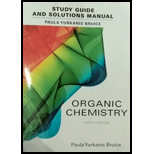
a)
Interpretation:
The products of the given reaction has to be stated.
Concept Introduction:
b)
Interpretation:
The products of the given reaction has to be stated.
Concept Introduction:
Aromatic compounds undergo electrophilic and nucleophilic substitution reactions and the position of electrophile and nucleophile is determined by the substituent already present on it. Activating groups direct incoming species toward ortho and para position and deactivating groups toward meta position.
c)
Interpretation:
The products of the given reaction has to be stated.
Concept Introduction:
Aromatic compounds undergo electrophilic and nucleophilic substitution reactions and the position of electrophile and nucleophile is determined by the substituent already present on it. Activating groups direct incoming species toward ortho and para position and deactivating groups toward meta position.
d)
Interpretation:
The products of the given reaction has to be stated.
Concept Introduction:
Aromatic compounds undergo electrophilic and nucleophilic substitution reactions and the position of electrophile and nucleophile is determined by the substituent already present on it. Activating groups direct incoming species toward ortho and para position and deactivating groups toward meta position.
e)
Interpretation:
The products of the given reaction has to be stated.
Concept Introduction:
Aromatic compounds undergo electrophilic and nucleophilic substitution reactions and the position of electrophile and nucleophile is determined by the substituent already present on it. Activating groups direct incoming species toward ortho and para position and deactivating groups toward meta position.
f)
Interpretation:
The products of the given reaction has to be stated.
Concept Introduction:
Aromatic compounds undergo electrophilic and nucleophilic substitution reactions and the position of electrophile and nucleophile is determined by the substituent already present on it. Activating groups direct incoming species toward ortho and para position and deactivating groups toward meta position.
Want to see the full answer?
Check out a sample textbook solution
Chapter 18 Solutions
Student's Study Guide and Solutions Manual for Organic Chemistry
- Zeolites: environmental applications.arrow_forward" is The structure of the bicarbonate (hydrogen carbonate) ion, HCO3-, HCO3 best described as a hybrid of several contributing resonance forms, two of which are shown here. HO :0: :Ö: HO + Bicarbonate is crucial for the control of body pH (for example, blood pH: 7.4). A more self-indulgent use is in baking soda, where it serves as a source of CO2 CO₂ 2 gas, which gives bread and pastry their fluffy constituency. (i) Draw at least one additional resonance form. = (ii) Using curved "electron-pushing" arrows, show how these Lewis structures may be interconverted by movement of electron pairs. (iii) Determine which form or forms will be the major contributor(s) to the real structure of bicarbonate, explaining your answer on the basis of the criteria in Section 1-5.arrow_forwardWhich of these is the best use of a volumetric flask? measuring how much liquid it contains delivering a precise amount of liquid to another container holding solutions making solutions of precise concentrationarrow_forward
- You're competing on a Great British television game show, and you need to bake a cake. The quantity for each ingredient is given in grams, but you haven't been given a kitchen scale. Which of these properties would correlate with the mass of a baking ingredient like eggs or milk? Check all that apply. depth of color viscosity volume densityarrow_forwardDraw a Lewis structure for each of the following species. Again, assign charges where appropriate. a. H-H¯ b. CH3-CH3 c. CH3+CH3 d. CH3 CH3 e. CH3NH3+CH3NH3 f. CH30-CH3O¯ g. CH2CH2 - h. HC2-(HCC) HC2 (HCC) i. H202×(HOOH) H₂O₂ (HOOH) Nortonarrow_forwardIs molecule 6 an enantiomer?arrow_forward
- Show work. Don't give Ai generated solutionarrow_forwardCheck the box under each structure in the table that is an enantiomer of the molecule shown below. If none of them are, check the none of the above box under the table. Molecule 1 Molecule 2 Molecule 3 ----||| Molecule 4 Molecule 5 Molecule 6 none of the above mm..arrow_forwardShow work. don't give Ai generated solutionarrow_forward
- Check the box under each structure in the table that is an enantiomer of the molecule shown below. If none of them are, check the none of the above box under the table. Molecule 1 Molecule 2 Molecule 3 ----||| Molecule 4 Molecule 5 Molecule 6 none of the above mm..arrow_forwardUse the vapor-liquid equilibrium data at 1.0 atm. for methanol-water (Table 2-8 ) for the following: If the methanol vapor mole fraction is 0.600, what is the methanol liquid mole fraction? Is there an azeotrope in the methanol-water system at a pressure of 1.0 atmospheres? If water liquid mole fraction is 0.350, what is the water vapor mole fraction? What are the K values of methanol and of water at a methanol mole fraction in the liquid of 0.200? What is the relative volatility αM-W at a methanol mole fraction in the liquid of 0.200?arrow_forwardCheck the box under each structure in the table that is an enantiomer of the molecule shown below. If none of them are, check the none of the above box under the table. || |II***** Molecule 1 | Molecule 4 none of the above Molecule 2 Molecule 3 Х mm... C ---||| *** Molecule 5 Molecule 6arrow_forward
- Chemistry: Matter and ChangeChemistryISBN:9780078746376Author:Dinah Zike, Laurel Dingrando, Nicholas Hainen, Cheryl WistromPublisher:Glencoe/McGraw-Hill School Pub Co
 EBK A SMALL SCALE APPROACH TO ORGANIC LChemistryISBN:9781305446021Author:LampmanPublisher:CENGAGE LEARNING - CONSIGNMENT
EBK A SMALL SCALE APPROACH TO ORGANIC LChemistryISBN:9781305446021Author:LampmanPublisher:CENGAGE LEARNING - CONSIGNMENT

